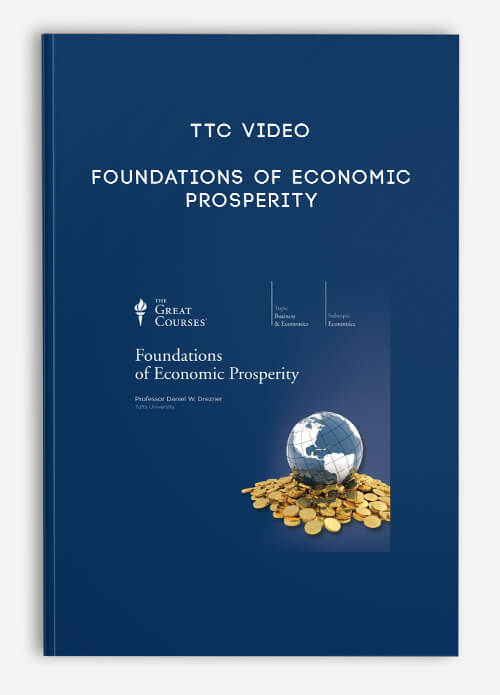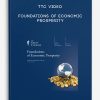TTC Video – Foundations of Economic Prosperity
Original price was: $254.95.$57.00Current price is: $57.00.
Product Include:
File size:
- Description
Description
TTC Video – Foundations of Economic Prosperity
**More information:
Get TTC Video – Foundations of Economic Prosperity at bestoftrader.com
Description
Prosperity has transformed the world. Defined as the ability to afford goods and services beyond basic necessities, prosperity is now a way of life for most residents of developed countries—so commonplace that few people realize what a rare and recent phenomenon it is.
A mere two centuries ago, most people lived at a subsistence level, in or near the edge of poverty, as the overwhelming majority had since prehistoric times. Then the Industrial Revolution began and per capita income shot up. It is still rising today.
But the story of prosperity is far from simple—or complete. Many people in the developed world fear that their children will be less prosperous than they are. Meanwhile, new economic titans such as China and Brazil enjoy year after year of rapid growth and an ever-rising standard of living. Elsewhere in the world, millions are still trapped in poverty, despite the best efforts of organizations such as the World Bank to help lift them out of it.
Fostering and sustaining economic prosperity—whether at the individual, national, or global level—is a multilayered endeavor that reaches far beyond economics into the political and social spheres. The complexity of the phenomenon raises equally complex questions:
Why is prosperity distributed so unevenly?
Why isn’t the path to prosperity predictable?
What, if anything, can be done to lift more people out of poverty?
Foundations of Economic Prosperity gives you an unrivaled overview of one of the most pressing issues of our day, in 24 half-hour lectures taught by Professor Daniel W. Drezner of the prestigious Fletcher School of Law and Diplomacy at Tufts University. Professor Drezner takes you behind the headlines and into the debates to dispel some common myths about prosperity and get at deeper truths.
In this stimulating, wide-ranging course, Professor Drezner shows that achieving prosperity involves more than economics. Psychology, sociology, political science, and history also come into play. By taking this broad view, he leads you to fundamental insights about how the modern world works and a deeper understanding of the functioning of the U.S., European, Chinese, and other major economies, as well as an appreciation for the special problems faced by underdeveloped nations.
Mysteries and Myths of Prosperity
Foundations of Economic Prosperity begins with an explanation of basic economic concepts. These are then applied to an increasingly wider sphere, covering prosperity on individual, national, and global scales. Noting that prosperity is surprisingly difficult to understand, Professor Drezner addresses some of the mysteries that surround the subject, including these:
Why England? The Industrial Revolution started in England, but scholars disagree about why, since other nations were also primed for change. Was England’s position in world politics the key factor? Or its institutions? One theory argues that the distinctive demography of the British gave them a crucial edge.
Riddle of the two Koreas: Few nations vary so radically in prosperity as North and South Korea. Yet both have the same natural resources, ethnicity, and culture. For the first 25 years of their existence, both countries showed remarkably similar growth patterns. What caused them to diverge so dramatically?
Easterlin paradox: A controversial finding by economist Richard Easterlin shows that there is no correlation between increasing prosperity and happiness in the developed world. How accurate is this conclusion? Does the effect change with levels of affluence? How much happiness can money buy?
In his quest to uncover the principles that guide the accelerating improvement of material life, Professor Drezner also refutes widely believed myths about prosperity, among them:
Myth—China is prosperous: China is economically powerful, but the view that it is prosperous is mistaken. By several different standards, China is still a developing country, ranking with nations such as Jamaica, Turkmenistan, and Belarus in per capita income, health, education, and other measures of prosperity.
Myth—Character is all: While individual behavior matters a great deal, people can’t entirely control their own economic destiny. National and global conditions matter. For example, Steve Jobs could not have built Apple Computer in a country that did not offer educational opportunities and a technology infrastructure.
Myth—Prosperity is self-sustaining: The idea that once achieved, prosperity is self-sustaining is a misconception. Many factors can derail prosperity, from pandemics to financial crises. Professor Drezner uses Argentina as a case study of a once-prosperous nation that went into a prolonged economic decline.
Successes and Failures
Foundations of Economic Prosperity follows dozens of case histories that illustrate what works and doesn’t work in the drive to increase economic growth. A superb storyteller, Professor Drezner reaches back to examples such as the statue-building culture of Easter Island that prospered centuries ago, until its mammoth public-works effort destroyed the island’s ecosystem—a cautionary tale to all developed societies. In another lesson from the past, Professor Drezner describes the economic policy called mercantilism that trapped European powers in growth-killing trade practices from the 16th to 18th centuries.
You will also learn about the following intriguing examples of prosperity won or lost:
Financial bubbles: The Dutch tulip mania in 1637 saw the value of a single tulip bulb rise to 45 times Holland’s per capita income. The price soon crashed in a boom/bust scenario that has been replayed many times, for instance in the “dot com” bubble in 1999–2000 and the housing bubble that led to the 2008 financial crisis.
Globalization: The trend toward an integrated world economy is not a recent phenomenon. The era of globalization that started in the 1850s and ended with World War I brought far more dramatic changes than those seen today—in communication, transportation, productivity growth, and financial innovation.
Politics versus prosperity: After the breakup of the Soviet Union, many economists predicted a bright economic future for Ukraine—because of its well-educated workforce, heavy industry, and productive farmland. But Ukraine did not do well. The missteps made by its politicians illustrate the enormous power of the state to get things wrong.
Prosperity Tips You Can Use
How can individuals capitalize on long-term trends in the growth and distribution of prosperity? Professor Drezner—whose experience extends beyond academia to include positions with the U.S. Department of the Treasury and the RAND Corporation, as well as extensive international travel and consulting—is full of insight on this question. He suggests, for example, that developments since 1980 underscore the increasing importance of human capital over physical capital—the value gained from investing in people over physical assets. Human capital is the product of education in all its forms, from elementary literacy to job training to undergraduate and graduate studies, and it is more important than ever to a person’s economic prospects.















